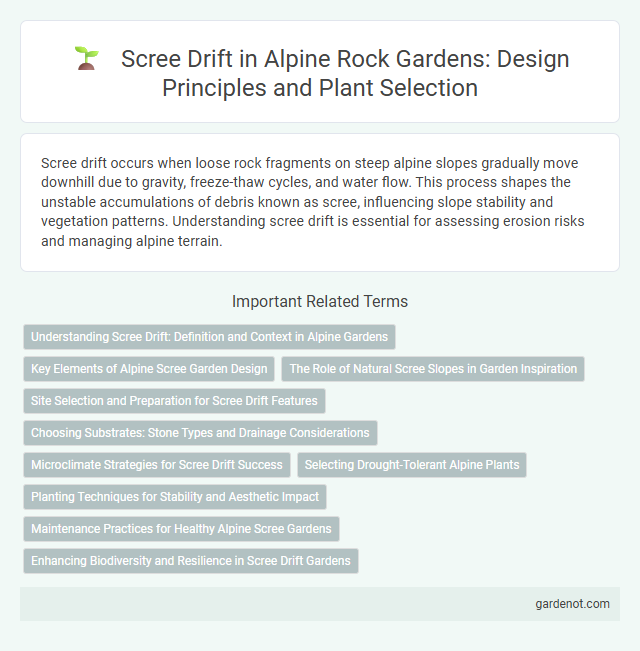Scree drift occurs when loose rock fragments on steep alpine slopes gradually move downhill due to gravity, freeze-thaw cycles, and water flow. This process shapes the unstable accumulations of debris known as scree, influencing slope stability and vegetation patterns. Understanding scree drift is essential for assessing erosion risks and managing alpine terrain.
Understanding Scree Drift: Definition and Context in Alpine Gardens
Scree drift refers to the gradual movement and accumulation of loose rock debris, known as scree, down slopes in alpine environments. This natural process shapes alpine garden landscapes by influencing soil composition and plant distribution, promoting specific adaptations in vegetation. Understanding scree drift helps in designing resilient alpine gardens that mimic natural erosion and sedimentation patterns.
Key Elements of Alpine Scree Garden Design
Scree drift in Alpine scree garden design emphasizes the strategic placement of angular rocks and gravel to mimic natural erosion patterns, promoting efficient water drainage and root aeration. Selecting hardy, drought-resistant alpine plants such as saxifrage, edelweiss, and sedum complements the rocky substrate, enhancing biodiversity and resilience. Incorporating gradual slopes and layering varied rock sizes optimizes microhabitats, supporting plant stability and naturalistic aesthetics.
The Role of Natural Scree Slopes in Garden Inspiration
Natural scree slopes provide a dynamic template for garden design by showcasing the chaotic beauty of Alpine debris fields. These formations of loose rock fragments demonstrate natural erosion processes and offer inspiration for creating textured, layered garden landscapes that mimic rugged mountain environments. Leveraging the unique mineral composition and drainage properties of scree drift enhances plant selection suited for alpine and xeriscape garden themes.
Site Selection and Preparation for Scree Drift Features
Site selection for scree drift features prioritizes stable slopes with well-draining, coarse rock fragments typical of alpine scree environments. Preparation involves clearing fine sediments and organic material to expose angular rock surfaces that facilitate natural debris movement and retention. Optimizing site orientation to reduce water accumulation enhances the stability and longevity of scree drift formations in alpine terrain.
Choosing Substrates: Stone Types and Drainage Considerations
Selecting substrates for alpine scree involves prioritizing stone types like granite, basalt, or quartzite due to their durability and resistance to weathering. Proper drainage is essential, with coarse gravel and sand layers facilitating water flow to prevent root rot and erosion. Ensuring a balance between stone size and soil porosity promotes optimal aeration and stability for alpine plant roots.
Microclimate Strategies for Scree Drift Success
Scree drift in alpine environments relies heavily on microclimate strategies that mitigate temperature extremes and retain soil moisture critical for vegetation establishment. The interaction of wind patterns, sun exposure, and substrate composition creates localized microhabitats that reduce frost damage and support nutrient cycling within the unstable scree matrix. Effective scree drift success depends on optimizing these microclimate conditions to promote pioneer species colonization and stabilize the scree slopes against erosion.
Selecting Drought-Tolerant Alpine Plants
Scree drift, characterized by shifting loose rock fragments, demands selecting drought-tolerant alpine plants with deep root systems to anchor effectively and withstand fluctuating moisture levels. Species such as Sedum, Saxifraga, and Sempervivum exhibit exceptional resilience to arid conditions and soil instability common in alpine scree environments. Optimizing plant selection based on drought tolerance enhances landscape stability and supports biodiversity in these challenging high-altitude ecosystems.
Planting Techniques for Stability and Aesthetic Impact
Scree drift planting techniques emphasize selecting native alpine species with deep root systems to enhance soil stability and prevent erosion. Utilizing a mix of cushion plants, sedges, and hardy perennials creates a natural visual flow that mimics undisturbed scree environments while promoting biodiversity. Strategic placement of drought-tolerant and frost-resistant plants ensures long-term resilience against harsh alpine conditions, improving both ecological function and aesthetic appeal.
Maintenance Practices for Healthy Alpine Scree Gardens
Regular removal of debris and invasive species is essential to maintain healthy alpine scree gardens, promoting native plant regeneration and preventing soil erosion. Controlled watering mimics natural precipitation patterns, supporting the unique moisture needs of scree ecosystems without causing root rot or fungal growth. Periodic assessment of substrate stability ensures optimal drainage and nutrient availability, crucial for sustaining alpine flora in scree drift environments.
Enhancing Biodiversity and Resilience in Scree Drift Gardens
Scree drift gardens enhance biodiversity by mimicking natural alpine scree environments, supporting specialized plants adapted to rocky, well-drained soils. This cultivation technique promotes ecological resilience through diverse root structures that stabilize soil and reduce erosion, fostering habitat complexity for insects and small wildlife. Integrating native alpine species in scree drift gardens creates sustainable ecosystems, improving overall environmental health in mountainous regions.
Scree drift Infographic

 gardenot.com
gardenot.com